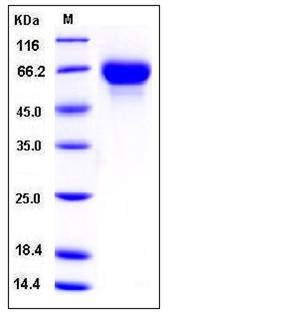Human GFRA2 / GFRα2 / GDNFRB Protein (His Tag)
GDNFRB,NRTNR-ALPHA,NTNRA,RETL2,TRNR2
- 100ug (NPP3890) Please inquiry
| Catalog Number | P10331-H08H |
|---|---|
| Organism Species | Human |
| Host | Human Cells |
| Synonyms | GDNFRB,NRTNR-ALPHA,NTNRA,RETL2,TRNR2 |
| Molecular Weight | The recombinant human GFRα2 consists of 431 amino acids after removal of the signal peptide and predicts a molecular mass of 48.2 kDa. As a result of glycosylation, the apparent molecular mass of rhGFRα2 is approximately 60-70 kDa in SDS-PAGE under reducing conditions. |
| predicted N | Ser 22 |
| SDS-PAGE |  |
| Purity | > 98 % as determined by SDS-PAGE |
| Protein Construction | A DNA sequence encoding the human GFRα2 (NP_001486.4) without the propeptide (Met 1-Ser 441) was fused with a polyhistidine tag at the C-terminus. |
| Bio-activity | |
| Research Area | Cancer |Signal transduction |Protein Phosphorylation |Tyrosine Kinase |Receptor Tyrosine Kinases |
| Formulation | Lyophilized from sterile PBS, pH 7.5 1. Normally 5 % - 8 % trehalose, mannitol and 0.01% Tween80 are added as protectants before lyophilization. Specific concentrations are included in the hardcopy of COA. |
| Background | GFRA2 is a member of the GDNF receptor family. It is a glycosylphosphatidylinositol(GPI)-linked cell surface receptor for both GDNF and NTN, and mediates activation of the RET tyrosine kinase receptor. GFRA2 is a potent survival factor for central and peripheral neurons, and is essential for the development of kidneys and the enteric nervous system. Glial cell line-derived neurotrophic factor (GDNF) and neurturin (NTN) are its binding ligand which are two structurally related, potent neurotrophic factors that play key roles in the control of neuron survival and differentiation. GDNF promotes the formation of a physical complex between GFRA/GDNFRa and the orphan tyrosin kinase receptor Ret, thereby inducing its tyrosine phosphorylation. The RET is a receptor tyrosine kinase representing the signal-transducing molecule of a multisubunit surface receptor complex for the GDNF, in which GFRA/GDNFRa acts as the ligand-binding component. Experiments have improved that GFRA2 genetic variants and age may play a role in Tardive dyskinesia (TD) susceptibility, but further work is required to confirm these findings. |
| Reference |
